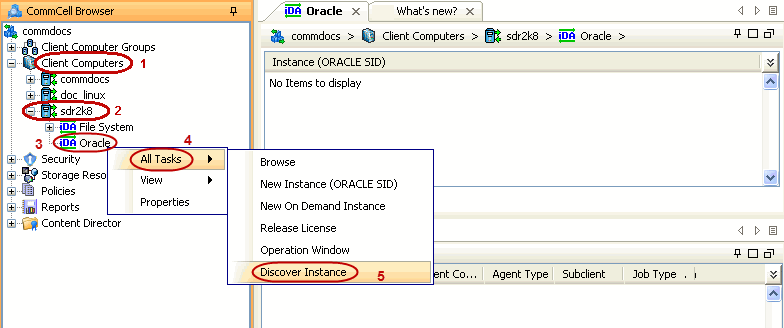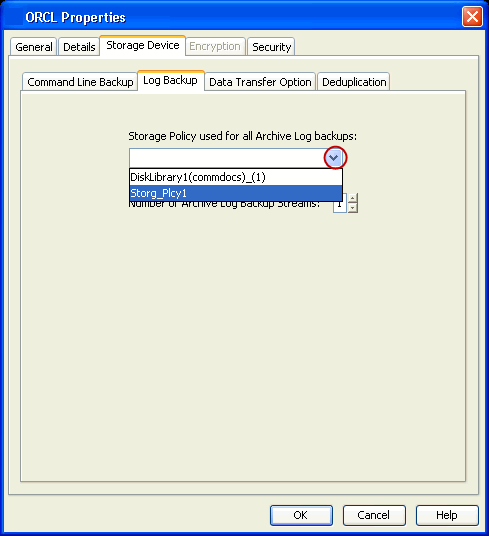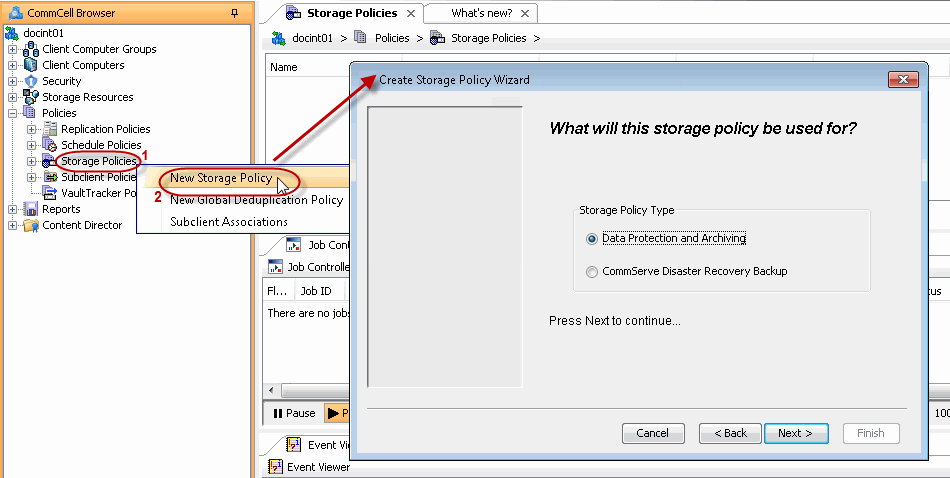| 1. |
- From the CommCell Browser, navigate to Client Computers | <Client>.
- Right-click Oracle and then
click Properties.
- Select the Enable Instance Discovery check box.
|
 |
| 2. |
- From the CommCell Browser, navigate to Client Computers | <Client>.
- Right-click Oracle, point to All Tasks and then
click Discover Instance.
|
 |
| 3. |
Click Yes. |
 |
| 4. |
- From the CommCell Browser, navigate to Client Computers | <Client>|Oracle.
- Right-click the <Instance> and then click Properties.
Automatic instance discovery will not detect the manually created
databases.
If Instances are not discovered, create an instance manually. See
Enabling Automatic
Instance Discovery and
Manually Adding an
Instance for more information. |
 |
| 5. |
On Windows clients:
- Click Change.
- In the User Account box, enter the user name to access the Oracle application.
- In the Password box, enter the password for the user account.
- In the Confirm Password box, re-confirm the password.
- Click OK.
Skip this step if you have a Unix client. |
 |
| 6. |
- Click the Storage Device tab.
- In the Storage Policy used for user command backup of data
box, select a storage policy name.
If you do not have a storage policy created, go to
step 10 to create a storage
policy. |
 |
| 7. |
- Click the Logs Backup tab.
- In the Storage Policy
used for all Archive Log backups box, select a storage policy name.
- Click OK.
If you do not have a storage policy created, go to
step 10 to create a storage
policy. |
 |
| 8. |
- From the CommCell Browser, navigate to Client Computers | <Client> |
Oracle | <Instance>.
- Right-click the default subclient and
then click Properties.
|
 |
| 9. |
- Click the Storage Device tab.
- In the Data Storage Policy list, select a Storage Policy name.
- Click OK to convert the next backup as a full backup.
- Click OK.
Click
 to continue. If you do not
have Storage Policy created, follow the step given below to create a
storage policy. to continue. If you do not
have Storage Policy created, follow the step given below to create a
storage policy. |
 |
| 10. |
Create a Storage Policy:
- Click Create Storage Policy.
- Follow the prompts displayed in the Storage Policy Wizard. The required
options are mentioned below:
- Select the Storage Policy type as
Data Protection and Archiving and click Next.
- Enter the name in the Storage Policy Name box and click
Next.
- From the Library list, click the name of a disk library
to which the primary copy should be associated and then click
Next.
Ensure that you select a library attached to a
MediaAgent operating in the current release.
- From the MediaAgent list, click the name of a MediaAgent
that will be used to create the primary copy and then click Next.
- For the device streams and the retention criteria information,
click Next to accept default values.
- Select Yes to enable deduplication for the primary copy.
- From the MediaAgent list, click the name of the
MediaAgent that will be used to store the Deduplication store.
Type the name of the folder in which the deduplication database must
be located in the Deduplication Store Location or click the Browse
button to select the folder and then click Next.
- Review the details and click
Finish to create the Storage Policy.
|
 |















